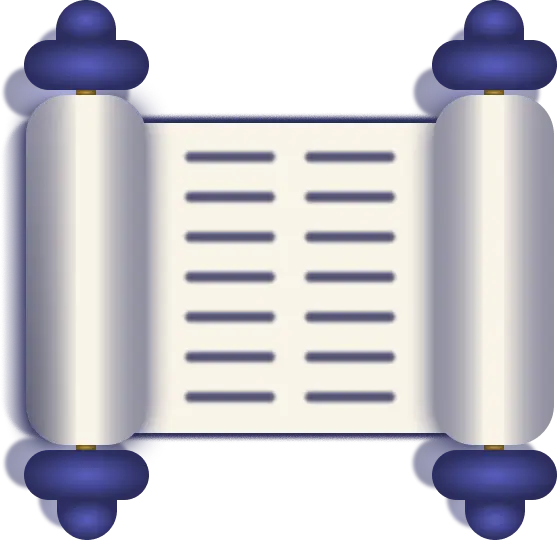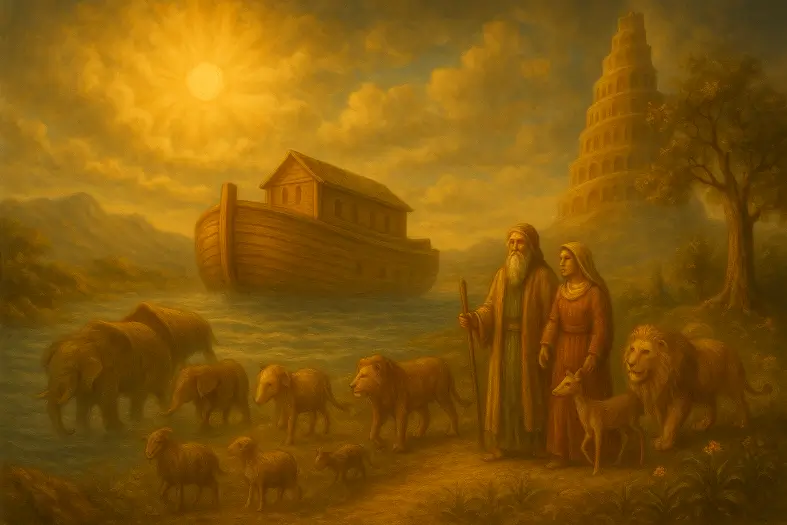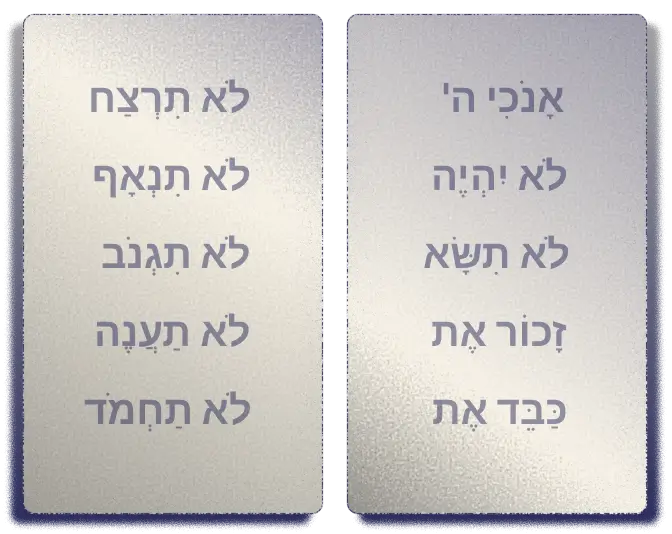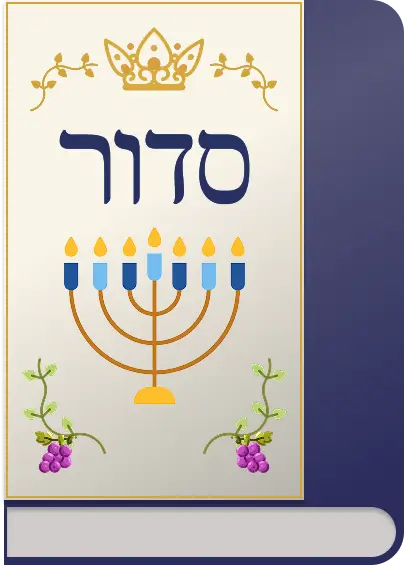



Noach tells of a world undone by corruption and renewed through faith. At Hashem’s command, Noach builds the Teivah, preserving his family and every species as the Flood engulfs the earth. When the waters subside, he offers korbanot, and Hashem establishes the eternal bris of the rainbow—pledging never again to destroy creation by water. Humanity rebuilds, but pride rises with the Migdal Bavel, where unity turns to rebellion and language becomes divided. The parsha closes with the Toldot Noach, tracing the line from Noach to Avraham—the dawn of a new covenantal destiny.






Rashi:
Rashi highlights that Noach is called both “a righteous man in his generations” and “walked with G-d.” He explains that while Avraham strengthened himself to walk before Hashem, Noach required Divine assistance to sustain his righteousness in an age of pervasive corruption. Still, Noach’s integrity amidst depravity reveals that a single person’s righteousness can uphold an entire world.
Rashi also comments on the Teivah’s construction: Hashem delayed the punishment for 120 years, allowing mankind the chance to repent as Noach built the Ark in public view. Mercy preceded judgment; even destruction came with an opening for teshuvah.
📖 Sources:
Rambam emphasizes that the Mabul (Flood) was not a suspension of natural law but a manifestation of Divine hashgachah (providence) operating through nature.
When humanity’s corruption (chamas) overturned moral order, the balance of creation itself was disturbed. The “fountains of the deep” and “windows of heaven” express this harmony between the physical and the ethical — nature echoing moral disorder.
📖 Sources:
Rambam interprets Noach’s tzidkut (righteousness) as the ideal of the derech ha-emtza — the balanced path between extremes of indulgence and asceticism.
While his generation drowned in excess and violence, Noach walked a steady moral line: humility without weakness, strength without cruelty.
This exemplifies the Rambam’s teaching that the truly righteous person aligns seichel (reason) with da’at Elokim (knowledge of G-d).
📖 Sources:
For Rambam, the Teivah (Ark) symbolizes the domain of the intellect that shelters truth amidst the floodwaters of ignorance.
Just as the Ark preserved the seeds of creation, the mind devoted to chochmah (wisdom) preserves the divine image within humanity.
The Flood thus becomes an allegory for the ethical necessity of intellectual mastery over base impulse — the harmony of reason reflecting the order of creation.
📖 Sources:
Rambam rejects any notion of G-d “changing His mind.”
The Keshet (rainbow) represents not a new phenomenon but a new understanding: humanity perceives the constancy of Divine mercy expressed in unchanging natural law.
G-d’s covenant is therefore rational and moral, not arbitrary — a reminder that the Creator governs creation consistently, and that faith means trusting this order.
📖 Sources:
Noach’s intoxication, Rambam teaches, is a parable of man’s duality: intellect and passion.
Drunkenness symbolizes surrender of reason — the reversal of creation’s divine hierarchy where seichel must rule the senses.
Noach’s lapse demonstrates that moral perfection lies not in angelic abstinence but in continual vigilance of intellect over appetite.
📖 Sources:
The builders of the Migdal Bavel embody the corruption of wisdom when divorced from reverence.
Rambam reads this as the tragedy of human pride: intellect exalting itself as divine, severed from humility.
When knowledge loses moral direction, language — the very medium of thought — collapses into confusion.
📖 Sources:
For Rambam, the arc of Parashas Noach is the re-creation of moral order through intellect and faith.
The Flood purges corruption; the rainbow restores covenant; and Avraham’s birth begins humanity’s conscious relationship with Divine wisdom.
To live wisely is to live covenantally — uniting knowledge, humility, and compassion in harmony with G-d’s world.
📖 Key References:
Ibn Ezra – Unity, Pride, and the Tower of Babel
Ibn Ezra reads the story of Noach and the subsequent Tower of Babel as philosophical mirrors of human aspiration and failure.
The generation of the Flood lacked unity in righteousness; the generation of Babel achieved unity but misused it for arrogance and rebellion. True progress, Ibn Ezra teaches, is not found in technological or social strength alone, but in the humility to align collective power with Divine purpose.
The moral tension between individual virtue and collective pride defines human civilization’s ongoing test.
📖 Source:
Yeshivat Har Etzion – The Sign of the Rainbow
This modern philosophical essay explains that the rainbow symbolizes not only G-d’s promise to never again destroy the world, but also humanity’s duty to sustain creation.
The covenant after the Mabul marks a new spiritual order — one founded on responsibility rather than innocence. Just as the rainbow unites light and color into one harmony, so too must humanity unite moral diversity under Divine awareness.
Every rainbow, the article concludes, is a living call for ethical renewal and faith in G-d’s compassion.
📖 Source:
Or HaChaim
The Or HaChaim explains that Noach’s name — from neichah (comfort, rest) — reveals his mission: to bring menuchah (serenity) to a turbulent world. The Teivah was not only physical protection but a spiritual refuge where holiness could dwell while the world was being renewed.
He further interprets Hashem’s command “Bo el ha-Teivah” (“Enter the Ark”) as a timeless call: in every generation, one must “enter the words (teivot) of Torah and tefillah,” finding sanctuary in sacred speech and study amidst worldly chaos.
📖 Source:
Sfas Emes
The Sefat Emet teaches that the story of Noah is more than a historical event — it’s a map of the soul’s journey. He writes that the ark symbolizes the teivah of Torah and prayer: when the world floods with chaos, the soul enters the words of Torah and finds refuge. Scribd+1
In his words, “Just as Noah entered the physical ark, so every Jew can enter the teivah of Torah and tefillah when the waters of confusion rise.” Scribd+1
The Sefat Emet connects the rainbow’s emergence after the storm to the revelation of hope: when adversity has passed, the soul sees the colours of G-d’s covenant — a visible promise that rebuilding is possible, and that Divine mercy sustains even the lowest point.
📖 Source:
Rabbi Jonathan Sacks zt"l
Rabbi Sacks writes that Noach’s story is about moral responsibility and the courage to be righteous alone. In a generation that mocked virtue, Noach built a world-saving Teivah — a metaphor for moral conviction in a flood of conformity.
He notes that the rainbow’s message is deeply ethical: diversity is not a threat to unity but its expression. The world endures not through uniformity but through covenant — through human partnership with Hashem to uphold life and justice.
📖 Source:
Rav Avraham Yitzchak HaKohen Kook
Rav Kook sees the Mabul as a stage in humanity’s spiritual evolution — the cleansing of the old world to prepare for Avraham and the emergence of faith. Every descent, he writes, conceals a tikun (rectification) that births new light.
The rainbow embodies this transformation: when the pure light of Elokus (Divinity) passes through the prism of creation, it becomes the multicolored beauty of human expression. Each color, each soul, reflects a facet of the Divine.
📖 Source:
Noach teaches that even one person’s faith can preserve the world.
In times of moral confusion, we are called to build our own Teivah — a life of Torah, tefillah, and chesed that shelters the spark of holiness within us and radiates it outward.
The Keshet (rainbow) reminds us that Divine judgment is never final — that renewal always follows destruction. When we act with integrity, gratitude, and compassion, we become living signs of the covenant — transforming storms into rainbows and chaos into peace.
📖 Supporting Sources:


Rashi begins with the verse:
“Noach ish tzaddik tamim hayah bedorotav — Noach was a righteous man, perfect in his generations.” (Bereishit 6:9)
He explains the phrase “in his generations” in two ways:
Rashi’s dual reading reflects the Torah’s nuanced moral lens: greatness is contextual, but even limited virtue has cosmic value when it resists corruption.
📖 Sources:
Hashem commands Noach to build the Teivah (Ark), giving exact measurements and materials. Rashi notes that Hashem could have saved Noach miraculously, yet chose a natural means — a 120-year construction — to allow others to see and repent.
The Teivah became a silent sermon of repentance (teshuvah). Every hammer’s strike was a chance for the generation to awaken before the decree was sealed.
📖 Sources:
Rashi comments that the verse “Vayehi hageshem al ha’aretz” (“And the rain was upon the earth”) reveals Hashem’s compassion: at first it was rain, not floodwater. Had the generation repented, those same rains would have blessed the land.
Only when repentance failed did the rains intensify into the destructive Mabul. Punishment in Torah, Rashi teaches, begins as an invitation to mercy.
📖 Sources:
Rashi describes the Ark as an olam katan (microcosm of creation). Each creature had its time and need, and Noach tended to them all, even at the cost of sleep. The Teivah thus became a world of harmony sustained by compassion and diligence.
When the waters subsided, Noach waited for Hashem’s command to leave — demonstrating obedience even after salvation. Patience and humility define righteousness as much as courage.
📖 Sources:
Upon emerging, Noach offers korbanot (sacrifices), and Hashem establishes a bris olam — an eternal covenant symbolized by the keshet (rainbow).
Rashi explains that the rainbow’s shape — a bow turned heavenward — signifies peace: the “weapon” is reversed. Hashem’s anger is withdrawn. The rainbow is thus a heavenly reminder of Divine mercy prevailing over strict justice.
📖 Sources:
After the flood, Noach plants a vineyard and becomes intoxicated. Rashi notes that the same man who preserved creation now falters through indulgence. Spiritual triumph must be guarded by self-discipline; success tests righteousness more than suffering.
Cham’s disrespect contrasts sharply with Shem and Yafet’s modesty. Rashi praises their reverence — they walked backward to cover their father — exemplifying kavod habriyot (human dignity) and the sanctity of restraint.
📖 Sources:
Rashi teaches that the generation of Migdal Bavel sought not Heaven but rebellion — “Let us build a city and a tower with its top in the heavens.” Their sin was not idolatry alone, but arrogant self-sufficiency.
Hashem’s response was measured: He did not destroy them but dispersed them, confusing their speech. Their punishment, midah k’neged midah (measure for measure), fit their sin — they misused unity, so unity was taken from them.
📖 Sources:
Rashi’s commentary on Parashat Noach weaves a story of moral renewal.
The world’s destruction is not despair, but rebirth; the flood cleanses, the covenant restores, and human dignity endures.
Noach’s Teivah becomes an eternal symbol of refuge — a sacred vessel of obedience, compassion, and faith. Even when society collapses, the righteous soul sustains the future.
📖 Key References:


Ramban:
Ramban explores the moral order behind the Flood. The sin of the generation was not only idolatry or theft, but chamas — the breakdown of social justice and moral restraint. The Mabul, he writes, was not arbitrary destruction but mishpat Elyon, a Divine purification of the world’s foundations.
When the waters receded, the Bris Keshet (rainbow covenant) revealed Hashem’s continued love for creation. The rainbow’s blend of light and color reflects the harmony between strict justice (din) and mercy (rachamim), reminding humanity that Divine judgment is always tempered by compassion.
📖 Source:
Ramban – The Covenant of Peace and Moral Order
Ramban explains that the rainbow, the Bris Keshet, serves as an everlasting reminder of G-d’s mercy and the moral covenant between Heaven and Earth.
When the bow is turned upward, away from the world, it symbolizes Divine restraint — like a warrior lowering his weapon. The Flood was not a random act of wrath, but a re-creation of moral order; the rainbow ensures that mercy will forever temper judgment.
Ramban teaches that the continued existence of the world depends on humanity’s moral behavior and recognition of G-d’s sovereignty.
📖 Source:


Sforno opens the parsha by explaining that the sin of the generation was not only violence but the corruption of potential. Humanity, created b’tzelem Elokim (in the image of G-d), had degraded itself into physical indulgence and injustice.
He notes the verse “Vatishachet ha’aretz lifnei ha’Elokim” (“The earth had become corrupt before G-d”) means mankind had perverted the purpose of existence — using intellect for selfish gain instead of divine service. The world, he writes, “could no longer sustain its moral decay.”
📖 Sources:
Sforno praises Noach as a man who “walked with G-d” — meaning he lived in constant awareness of Divine presence, guided by yir’ah (reverence) and seichel (reason).
Unlike his generation, whose greatness of intellect was misused for corruption, Noach’s wisdom served virtue. His righteousness lay not in asceticism but in balance — a moral harmony between intellect and desire, reflecting G-d’s image in action.
📖 Source:
On Hashem’s command to build the Teivah, Sforno highlights Divine restraint: G-d could have saved Noach by miracle but chose to work within nature, allowing time for repentance. The Teivah itself was a manifestation of chesed — protection for life while judgment purified the world.
Sforno remarks that Hashem delayed the Flood for 120 years, showing that His goal was not destruction but rehabilitation. Even as He decrees justice, His patience extends to the last possible moment of mercy.
📖 Sources:
Sforno explains that the Mabul was not primarily punitive but restorative. The overflowing waters purified the earth’s atmosphere and environment, allowing the world to begin anew in physical and spiritual purity.
He views the destruction as a cosmic mikveh — immersion for creation itself. Just as a sinner is renewed through teshuvah, so too the world was renewed through cleansing.
📖 Source:
After the Mabul, Hashem establishes the Bris Keshet (Rainbow Covenant). Sforno sees this as the ultimate symbol of Divine equilibrium — justice (din) tempered by mercy (rachamim).
The rainbow’s convergence of light and color teaches that harmony emerges from difference. Hashem’s promise “never again” does not remove judgment but regulates it, ensuring that destruction will never outweigh compassion. The rainbow, he writes, is “the visible sign of invisible mercy.”
📖 Source:
Sforno observes that Noach’s downfall through wine symbolizes the human tendency to misuse peace and prosperity. After surviving crisis, one must not sink into indulgence.
The Torah reveals Noach’s failure to teach that spiritual vigilance must continue even after salvation. Menuchah (rest) without purpose becomes regression. The righteous must sanctify peace as much as struggle.
📖 Source:
Sforno’s commentary on Migdal Bavel is profoundly psychological. Humanity, now united by language and vision, sought to control destiny through human intellect alone. Their goal, he writes, was “to preserve themselves eternally,” denying Divine providence.
The dispersion that follows is not pure punishment but correction — restoring the diversity necessary for humility. Sforno emphasizes that unity without holiness leads to tyranny; true progress requires moral direction rooted in awareness of Hashem.
📖 Sources:
Sforno concludes that Parashat Noach marks the transition from a world ruled by instinct to one guided by moral law. The sheva mitzvot bnei Noach (Seven Noahide Laws) given after the Flood anchor civilization in justice, compassion, and reverence.
From Noach to Avraham, the Torah traces the rebirth of humanity’s spiritual conscience — the beginning of history as a dialogue between Divine wisdom and human responsibility.
📖 Key References:


Abarbanel begins his commentary by asking: “Why did Hashem choose to destroy all living beings instead of merely punishing the guilty?”
He explains that the Dor HaMabul (generation of the Flood) had corrupted the very fabric of creation. Violence (chamas) and immorality had become so pervasive that humanity’s existence contradicted its purpose. Hashem’s justice, Abarbanel teaches, operates not only upon individuals but upon the moral ecosystem of the world.
The Flood was therefore a cosmic cleansing, not vengeance — erasing the distortion of creation and restoring balance so that life could begin anew in righteousness.
📖 Sources:
Abarbanel contrasts Noach with his generation: though surrounded by corruption, he maintained faith and obedience. However, Abarbanel notes that Noach’s righteousness was personal, not prophetic — he did not actively rebuke his contemporaries.
Thus, while Noach was saved for his integrity, he did not merit the title of reformer. The lesson: one must strive not only for self-preservation but to elevate society.
📖 Sources:
Abarbanel questions why Hashem provided such specific dimensions for the Ark (300 cubits long, 50 wide, 30 high) and why a physical Ark was necessary at all if G-d could save Noach miraculously.
He answers that the Teivah was both educational and symbolic. It taught the world that salvation requires effort and cooperation with Divine will. Its construction over many years was a public act of faith — a living sermon in wood and pitch.
The Ark’s three levels, Abarbanel adds, represent the hierarchy of existence: animal life, human life, and spiritual life — all sheltered together under G-d’s protection.
📖 Sources:
Abarbanel, the rationalist, analyzes whether the Flood was a natural phenomenon or a miraculous suspension of order. He concludes that while it was natural in appearance, its timing and totality were miraculous.
Rain and subterranean waters are natural forces, yet their synchronization — lasting exactly forty days and covering all the mountains — reflected precise Divine orchestration. G-d works through nature as a craftsman through his tools.
📖 Sources:
After the Mabul, Abarbanel interprets the Bris Keshet (Rainbow Covenant) as G-d’s renewal of creation’s moral framework. The rainbow, he teaches, is not a new phenomenon but a new meaning assigned to an existing one — a visible reminder that Divine anger will never again destroy the earth.
He notes the inverted bow symbolizes peace: when a warrior lowers his weapon, it signals truce. Likewise, G-d “turns His bow toward Heaven,” showing restraint and mercy. The covenant thus transforms natural beauty into moral memory.
📖 Sources:
Abarbanel reads Noach’s intoxication not as random weakness but as a philosophical lesson about human nature after crisis. When physical life is restored, man must beware of indulgence.
Wine, he explains, is the symbol of pleasure that tests wisdom: moderation reveals mastery, excess exposes folly. Noach’s lapse reminds us that moral vigilance must persist after deliverance — the moment of safety often invites new temptation.
📖 Source:
Abarbanel devotes an extended analysis to the Migdal Bavel episode, asking: What was their sin if their goal was unity?
He answers that their unity was founded on rebellion — they sought permanence without Divine dependence. The tower was humanity’s political project of self-deification, replacing G-d’s authority with centralized power.
Hashem’s response — confusing their language — was not merely punitive but preventive. Dispersion preserved human freedom and humility, ensuring no empire could again dominate all thought and speech.
📖 Sources:
Abarbanel closes his commentary by framing Parashat Noach as the blueprint for moral civilization. Divine judgment purges evil; covenant renews hope. Noach’s story demonstrates the rhythm of history: corruption, correction, and covenantal rebirth.
He writes that the Mabul was not the end but the beginning — the world’s first tikkun (repair). Through the rainbow, G-d invited humanity to become co-creators in sustaining moral order, preparing the way for Avraham, the father of faith.
📖 Key References:


Rabbi Miller highlights that Noach’s greatness was not in prophetic genius but in moral courage.
In a generation steeped in chamas — violence, theft, and immorality — Noach remained pure, obedient, and loyal to G-d. His righteousness was an act of heroism; when all mocked, he built. When others indulged, he restrained.
Noach’s example, Rabbi Miller teaches, is that one person’s integrity can uphold a world. Every mitzvah done in secret strengthens the moral foundation of creation itself.
Sources:
Rabbi Miller explains that the Mabul was not simple destruction, but a world-scale purification.
When mankind rejected justice and restraint, G-d “washed” the earth clean. Yet, even this act of judgment was accompanied by mercy — He delayed the punishment for 120 years, allowing time for teshuvah (repentance).
The Teivah (Ark) itself symbolized Divine compassion — a small sanctuary of life preserved amid chaos. Within it, Noach lived as a model of chesed — feeding and tending to every creature day and night, embodying G-d’s sustaining mercy.
Sources:
After the flood, G-d established the Bris Keshet (Rainbow Covenant).
Rabbi Miller interprets it not as a mere symbol of peace, but as a reminder of moral responsibility — a sign that the survival of the world depends on the behavior of humankind.
Whenever we see a rainbow, we are called to remember G-d’s patience and mercy. The colors reflect His promise that creation endures only through the balance of din (justice) and rachamim (compassion).
The rainbow is thus not just beauty in the sky — it’s a visual covenant reminding us that our deeds sustain the moral order of the universe.
Sources:
Rabbi Miller describes the Dor HaMigdol (generation of the Tower of Babel) as the first human attempt at godless utopia — unity without G-d.
They spoke one language and shared one goal, yet used that unity to rebel against Heaven.
G-d’s dispersion of languages was not punishment alone but protection — preventing the total corruption of human power.
Rabbi Miller warns that any society that seeks unity apart from Divine truth repeats the sin of Bavel. True progress is to serve G-d together, not replace Him together.
Sources:
Rabbi Miller often concluded that Parshas Noach speaks directly to modern times.
The floodwaters are a metaphor for spiritual confusion — the tides of media, immorality, and secular arrogance.
The Teivah represents our homes, our Torah study, our Shabbos tables, and our synagogues — places where holiness is preserved amidst chaos.
Each Jew is called to build his own Teivah — to live with modesty, loyalty, and awareness of G-d — until the world once again recognizes its Creator.
Sources:
Rabbi Avigdor Miller’s Noach reveals timeless truths:
In every age, the message of Noach endures: “Walk with G-d, even when the world flows against you.”

Dive into mitzvot, prayer, and Torah study—each section curated to help you learn, reflect, and live with intention. New insights are added regularly, creating an evolving space for spiritual growth.

Explore the 613 mitzvot and uncover the meaning behind each one. Discover practical ways to integrate them into your daily life with insights, sources, and guided reflection.

Learn the structure, depth, and spiritual intent behind Jewish prayer. Dive into morning blessings, Shema, Amidah, and more—with tools to enrich your daily connection.

Each week’s parsha offers timeless wisdom and modern relevance. Explore summaries, key themes, and mitzvah connections to deepen your understanding of the Torah cycle.